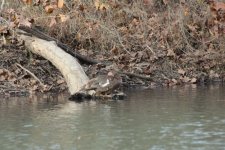OK_Scissortail
Oklahoma State Bird
I saw this one on a secluded pond..looks domestic to me but I have been wrong before. It was alone, no other ducks. This duck stayed perfectly still as if thinking if it doesn't move we won't see it.
Attachments
Last edited:






